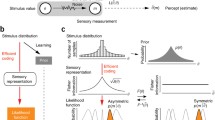Summary
In a complete identification experiment the three sides of an equilateral triangle were briefly presented as stimuli either singly or in pairs. The resulting 6×6 confusion matrices obtained with three subjects were analyzed according to Rumelhart's (1970, 1971) multicomponent theory of perception (MCTP) in order to test assumptions about feature extraction and decision processes. In agreement with MCTP the detection of a line segment occurring within a pair was stochastically independent of the detection of the other line segment. Two predictions of MCTP were however not confirmed: different line segments are not detected with equal probability, and the probability of detecting a line segment depends on the presence or absence of others. Several decision assumptions of MCTP were tested. The results are the following: If at most one line segment has been detected, then several responses (the candidate set) are compatible with this sensory state. It was argued that response selection from the candidate set is better described by the choice model (Luce, 1959) than by the matching Bayesian rule assumed by MCTP. For a given sensory state the size of the candidate set appears to vary over trials, whereas MCTP assumes it to be constant. In general, the confusion matrices could be predicted quite accurately by MCTP modified according to the above assumptions. However, more accurate predictions were achieved by assuming holistic perceptual processes as well as single feature extraction.
Similar content being viewed by others
References
Chandler, J. P.: Subroutine Stepit: An algorithm that finds the values of the parameters which minimize a given continuous function. A copyrighted program: J. P. Chandler. Quantum Chemistry Program Exchange. Bloomington, Ind.: Indiana University 1965
Green, D. M., Swets, J. A.: Signal detection theory and psychophysics. New York: Wiley 1966
Greeno, J. G., Steiner, T. E.: Comments on “Markovian processes with identifiable states: general considerations and applications to all-or-none learning”. Psychometrika, 33, 169–172 (1968)
Luce, R. D.: Individual choice behavior. New York: Wiley 1959
Nakatani, L. H.: Confusion-choice model for multidimensional psychophysics. J. Math. Psychol., 9, 104–127 (1972)
Neyman, J.: Contribution to the theory of the X2-test. In: Neyman, J. (Ed.), Proceedings of the Berkely symposium on mathematical statistics and probability. Berkely: University of California Press 1949
Rumelhart, D. E.: A multicomponent theory of the perception of briefly exposed visual displays. J. Math. Psychol. 7, 191–218 (1970)
Rumelhart, D. E.: A multicomponent theory of confusions among briefly exposed alphabetic characters. (Center for Human Information Processing Report No. 22), San. Diego: University of California 1971
Rumelhart, D. E., Siple, P.: Process of recognizing tachistoscopically presented words. Psychol. Rev. 81, 99–118 (1974)
Sperling, G. A.: A model for some kinds of visual memory tasks. Human Factors 5, 19–31 (1963)
Wandmacher, J.: Multiplicative confusion matrices of perceptual identification experiments. Konstanz: Berichte der Fachgruppe Psychologie an der Universität Konstanz, Bericht Nr. 1-74, 1974
Wandmacher, J.: Stimulus expectancy and stimulus frequency in visual identification. Konstanz: Berichte der Fachgruppe Psychologie an der Universität Konstanz, Bericht Nr. 1-75, 1975
Yellot, J. I., Jr., Curnow, P. F.: Second guess choices in a visual span of apprehension task. Perception & Psychophysics 2, 307–311 (1967)
Author information
Authors and Affiliations
Additional information
This study was supported by a grant from the Universität Konstanz, Forschungsprojekt 32/72 ‘Visuelle Reize’, and the experiment to this study was performed in the laboratory of the Arbeitseinheit Mathematische Psychologie im Fachbereich Psychologie/Soziologie der Universität Konstanz.
Rights and permissions
About this article
Cite this article
Wandmacher, J. Multicomponent theory of perception. Psychol. Res 39, 17–37 (1976). https://doi.org/10.1007/BF00308943
Received:
Issue Date:
DOI: https://doi.org/10.1007/BF00308943




